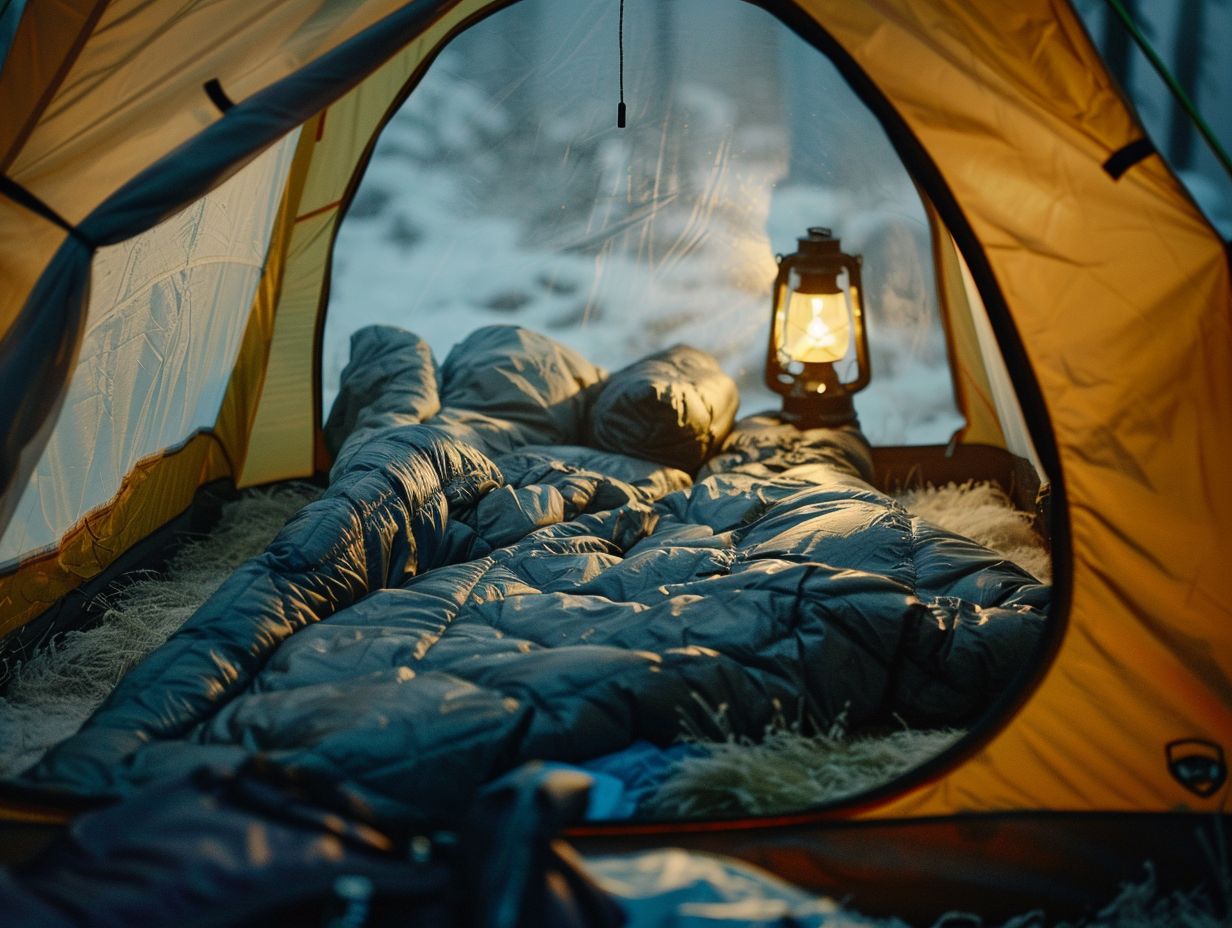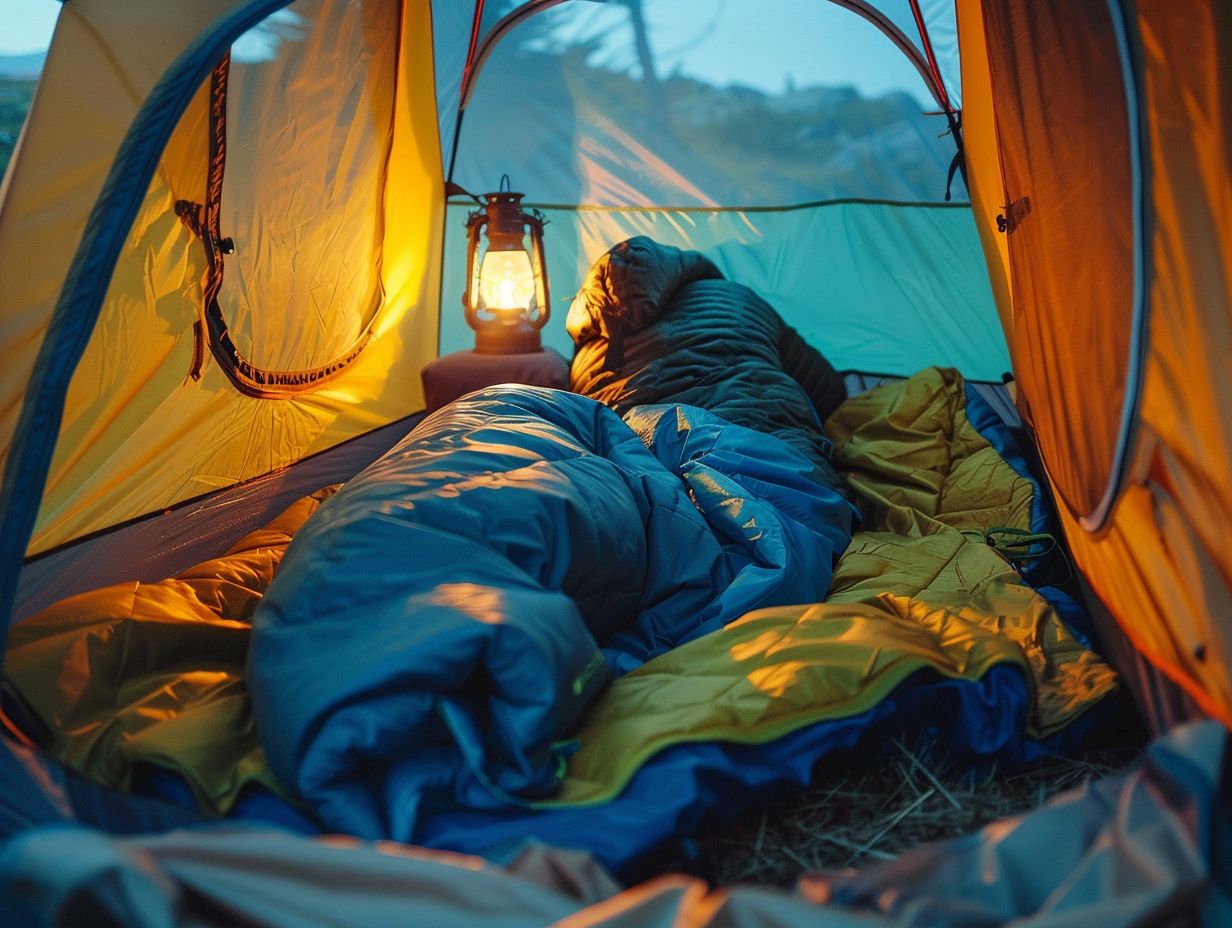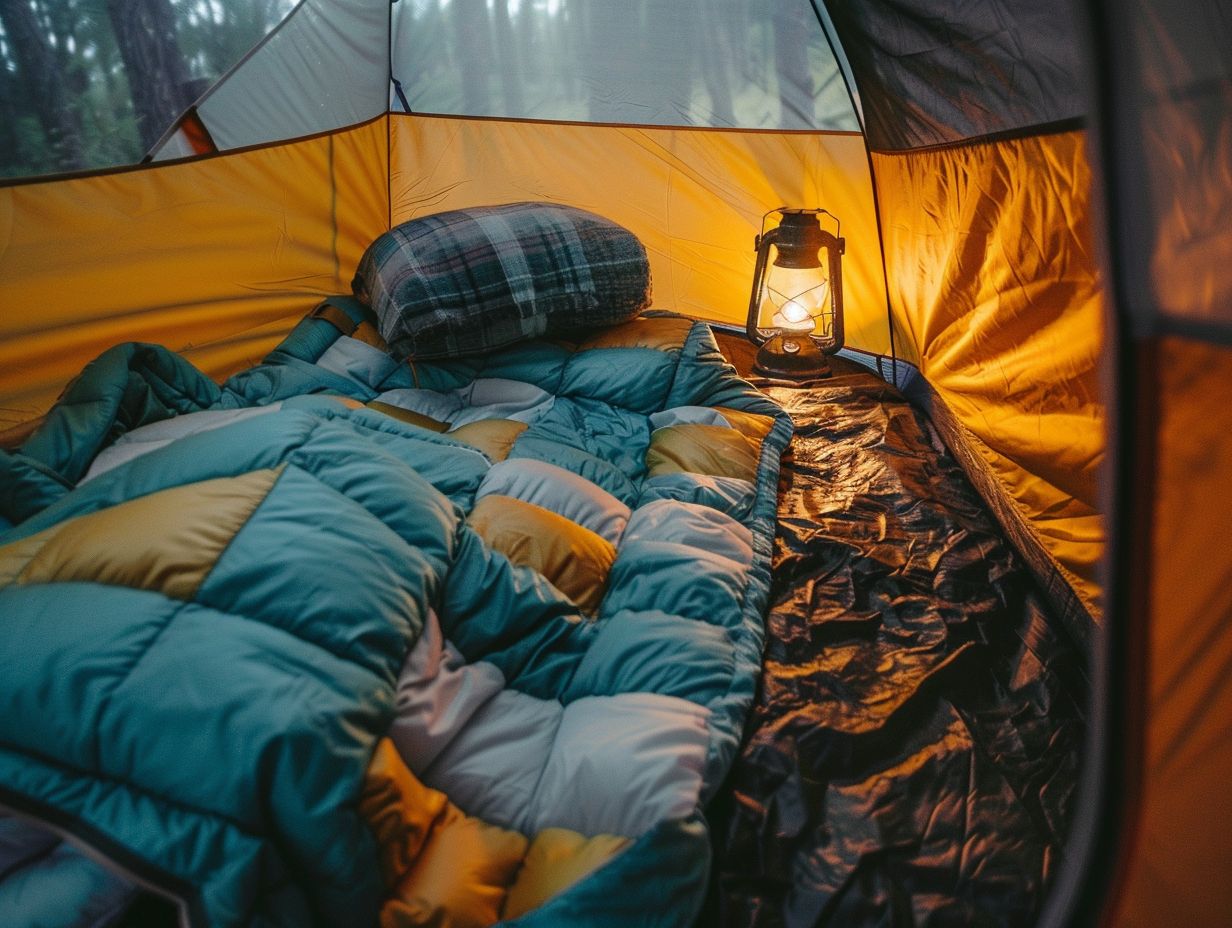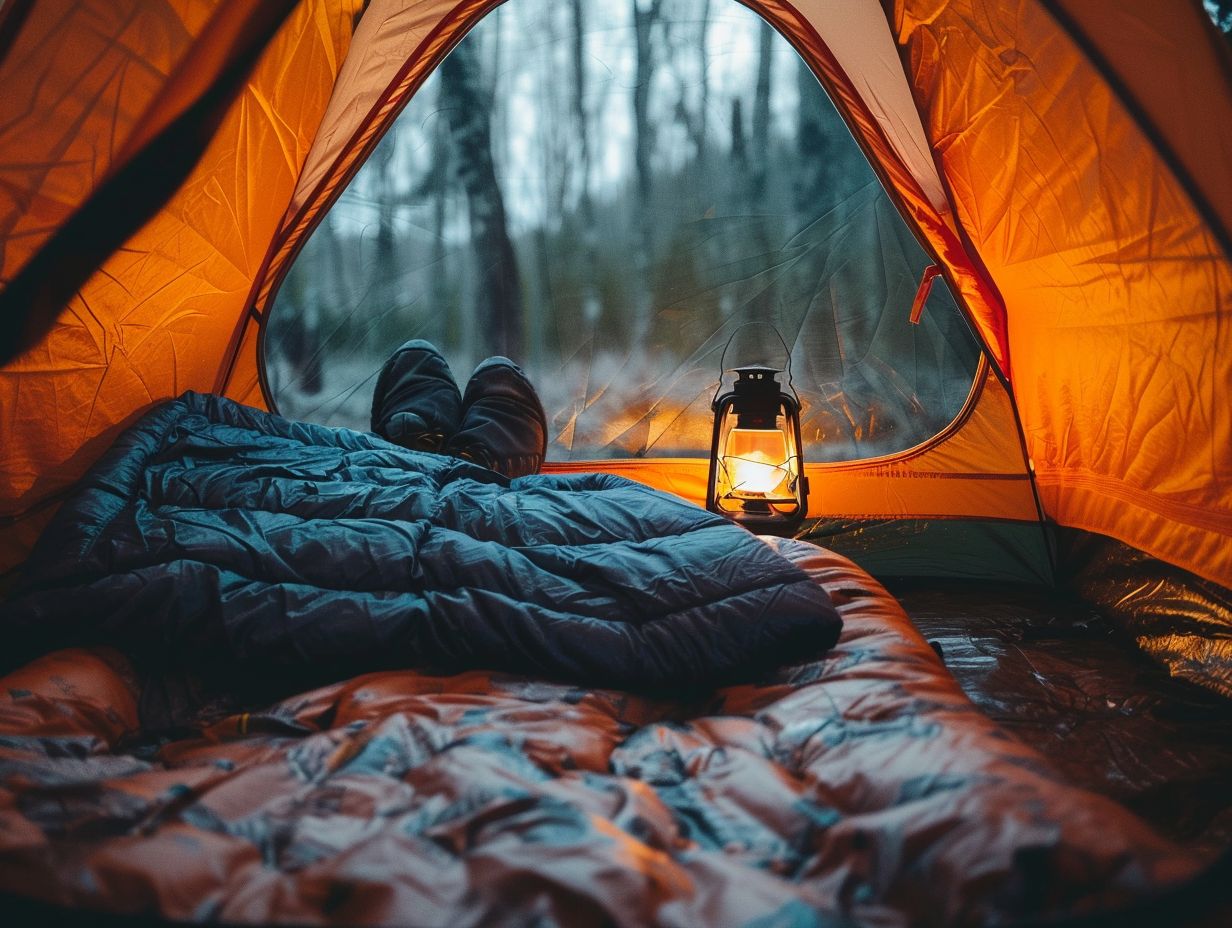Are you planning a camping trip and wondering how to ensure a good night’s sleep in your tent? From choosing the right tent size and material to setting up a cozy sleeping area with the perfect sleeping bag and accessories, this article has got you covered.
Learn about maximising airflow, keeping your tent clean and organised, and top tips for better sleep while camping. Say goodbye to restless nights and hello to a restful camping experience!
Key Takeaways:

- Choose the right tent size and material for sleeping comfort.
- Prepare your sleeping area with the right sleeping bag, pad or mattress, and cozy bedding.
- Maximise airflow and temperature control by strategic tent placement, using a rainfly or tarp, and utilising tent vents and windows.
Choosing the Right Tent for Sleeping Comfort
Selecting the appropriate tent for optimal sleeping comfort is a pivotal consideration for any camping trip, as it directly affects your ability to achieve a peaceful night’s sleep in the midst of the natural environment.
Whether one is an experienced tent camper or a novice to outdoor pursuits, the right sleeping system, which includes a high-quality sleeping bag and other essential camping gear, can greatly improve the overall camping experience.
What Size Tent Do You Need?
Selecting the correct tent size is essential to ensuring comfort and functionality throughout tent camping outings. When deciding on a tent, it is important to take into consideration the number of individuals with whom you typically camp.
It may be advisable to choose a larger tent, even for a smaller group, if you prefer ample personal space, as additional room can enhance the overall camping experience. Additionally, assess specific camping requirements, such as the necessity for gear storage or the preference for separate sleeping quarters.
By carefully evaluating these factors, you can select a tent size that accommodates both your comfort preferences and practical needs effectively.
What Type of Tent Material is Best for Sleeping Comfort?
The choice of tent material is a critical factor in ensuring optimal sleeping comfort, particularly when camping in various outdoor environments.
Canvas tents are renowned for their durability and insulation properties, making them well-suited for colder temperatures. In contrast, nylon tents are favoured for their lightweight nature and quick-drying capabilities, making them ideal for backpacking excursions. Polyester tents are widely recognised for their water-resistant features and UV protection.
Investing in premium-quality tent materials not only enhances comfort levels but also guarantees long-lasting performance and reliability throughout your outdoor endeavours. When selecting a tent material, it is advisable to assess aspects such as breathability, weather resistance, and overall construction quality to prioritise sleep quality during camping expeditions.
What Features Should You Look for in a Tent for Sleeping Comfort?
When one is in the process of selecting a tent to optimise sleeping comfort, it is imperative to take into account various features that can elevate the camping experience.
Ventilation emerges as a critical factor in sustaining a comfortable internal environment within the tent, preventing condensation and facilitating adequate air circulation. A well-ventilated tent equipped with mesh panels or windows facilitates airflow, ensuring a cool ambiance, particularly in warm conditions.
Furthermore, the interior space of the tent is paramount for accommodating camping gear and allowing comfortable movement within. It is advisable to seek tents with ample headspace and storage pockets to maintain organisational efficiency of personal belongings.
Additionally, consideration should be given to the tent’s compatibility with sleeping mats or alternative sleeping systems to secure a snug and supportive sleeping arrangement.
Preparing the Sleeping Area in Your Tent
Properly arranging the sleeping area within the tent is essential for ensuring a comfortable and restful night’s sleep during a camping excursion. By thoughtfully choosing the appropriate sleeping bag, sleeping mat, and other necessary items, individuals can establish an environment conducive to relaxation and rejuvenation.
Choosing the Right Sleeping Bag
The selection of an appropriate sleeping bag holds significant importance in ensuring warmth and comfort, particularly for individuals who tend to feel cold and engage in winter camping activities. Among the various types of sleeping bags available, down sleeping bags stand out as a popular choice due to their exceptional insulating properties and lightweight characteristics.
The down fill material is renowned for its high warmth-to-weight ratio, making it particularly suitable for use in cold climates. These sleeping bags often come with temperature ratings that specify the lowest temperatures at which they can offer sufficient warmth, thereby ensuring a comfortable night’s rest.
When considering a down sleeping bag, it is advisable to take into account factors such as fill power and fill weight to align the bag’s specifications with your specific requirements and the anticipated weather conditions during your outdoor excursions.
Using a Sleeping Pad or Air Mattress

Using a sleeping mat or air bed can have a transformative impact on the level of sleeping comfort experienced during camping expeditions. These sleeping aids offer a range of benefits that can significantly enhance one’s outdoor sleeping activities. The supportive padding provided by sleeping mats and air beds plays a crucial role in relieving pressure points, thereby promoting a more restful night’s sleep.
Moreover, they provide excellent insulation from the cold ground, ensuring warmth and comfort throughout the night. Of particular note are self-inflating mats, which feature user-friendly characteristics as they automatically inflate when unrolled, thus simplifying the setup process and saving time and effort.
When choosing a sleeping mat or air bed, it is recommended to consider factors such as thickness, material composition, and the inflation method to identify the most suitable option tailored to individual needs.
Creating a Cozy Atmosphere with Pillows and Blankets
Establishing a comfortable atmosphere within the tent necessitates the inclusion of cosy pillows, blankets, and suitable nightwear in the designated sleeping area. When considering the selection of pillows for the camping trip, it is advisable to choose compact yet supportive options to promote a restful night’s sleep.
To enhance comfort levels, it is recommended to layer blankets – with a thick one for insulation and a soft one for additional cosiness. Opting for nightwear crafted from moisture-wicking fabrics can contribute to maintaining dryness and comfort throughout the night.
Additionally, it is prudent to carry extra blankets in the event of unexpected temperature drops. By conscientiously selecting and arranging these essential items, one can create a warm and welcoming sleeping environment within the confines of the tent.
Maximising Airflow and Temperature Control
Ensuring optimal airflow and temperature control within the tent is imperative for establishing a conducive sleeping environment throughout the camping endeavor.
The prudent management of ventilation systems and the strategic deployment of tent components such as rainflies and windows can notably amplify the quality of the camping endeavor by effectively regulating internal temperature and mitigating condensation levels.
Strategic Tent Placement
The positioning of a tent in a strategic manner can significantly impact the comfort and overall experience of camping.
When determining a suitable location for pitching a tent, it is essential to take into account various factors to ensure a pleasant stay in the natural environment.
It is advisable to be mindful of the wind direction to avoid exposure to strong gusts that may lead to instability or excessive noise within the tent during nighttime.
Selecting a level ground for the tent setup is recommended to prevent discomfort and the potential risk of rolling off a sleeping pad.
Additionally, proximity to water sources plays a crucial role in facilitating easy access to water for activities such as cooking, cleaning, and maintaining hydration levels during the camping expedition.
Using a Rainfly or Tarp for Ventilation
The utilisation of a rainfly or tarp can significantly enhance the ventilation within your tent, thus improving the overall comfort of the sleeping area.
These additional accessories serve as a protective barrier between the tent and external elements, facilitating adequate airflow while also offering shade during sunny conditions.
To ensure their efficient functionality, it is imperative to securely affix the rainfly or tarp to the tent, covering it entirely to prevent the formation of gaps that could potentially trap warm air. Optimal positioning involves setting up the rainfly or tarp at an inclined angle to promote airflow.
Additionally, the utilisation of guy lines and pegs is recommended to maintain tautness and prevent any flapping in the wind, which could impede proper ventilation inside the tent.
Utilising Tent Vents and Windows
Proper utilisation of tent vents and windows is essential for maintaining optimal airflow and controlling the temperature inside the tent. Vents and windows play pivotal roles in ensuring adequate ventilation and regulating the internal temperature of the tent.
By strategically adjusting the opening and closing of these features, one can establish air circulation that prevents stagnation or uneven distribution of temperature within the tent.
To maximise the effectiveness of vents, it is advisable to position them opposite each other to facilitate cross ventilation. In the case of windows, maintaining a slight opening, even during rainfall, can be achieved by utilising rain fly covers or awnings to shield the interior from water infiltration.
By adeptly managing the operation of vents and windows, individuals can enjoy a comfortable and well-regulated climate within their camping accommodations.
Keeping Your Tent Clean and Organized
Maintaining cleanliness and organisation within your tent is crucial for enhancing the overall camping experience. This practice ensures that camping gear is readily accessible and that the sleeping area remains neat and comfortable. By utilising essential camping accessories like groundsheets and effectively organising personal items, individuals can uphold a clean and orderly tent environment.
Using a Groundsheet or Footprint

Using a groundsheet or ground cloth is essential for protecting the base of your tent and maintaining cleanliness during your tent camping trips. These additional items act as a protective barrier between the rough terrain and your tent, effectively preventing moisture buildup and potential damage.
They help to guard your tent base from dirt, stones, and other debris, thus avoiding punctures or stains that could weaken its durability. When choosing a groundsheet or ground cloth, it is recommended to select a strong material that fits perfectly with the size of your tent. Additionally, ensuring a stable positioning under your tent is vital to avoid any shifting.
By investing in a high-quality groundsheet or ground cloth, you can greatly enhance the comfort and lifespan of your camping gear.
Organising Your Gear and Personal Items
It is imperative to prioritise the organisation of your gear and personal belongings to ensure easy accessibility and efficient management during your camping excursion.
One highly effective approach to organising your possessions within the tent involves utilising specialised storage solutions such as hanging organisers or collapsible bins.
These items can assist in categorising your belongings and elevating them from the tent floor, thereby optimising available space. The integration of versatile items like storage hammocks or gear lofts can also provide additional storage alternatives.
Establishing distinct zones within the tent designated for various items, including sleeping gear, clothing, and toiletries, can further contribute to enhanced organisation.
Consistently maintaining cleanliness and returning items to their designated locations are fundamental practices in upholding a clutter-free tent environment throughout the entirety of your camping experience.
Maintaining a Clean Sleeping Area
It is imperative to uphold a tidy sleeping environment to promote comfort and hygiene throughout the duration of your camping excursion.
Consistently organising your sleeping bag and pillow, ensuring proper storage of personal belongings, serves to deter unwelcome pests and uphold a clean sleeping atmosphere.
Acquiring suitable sleepwear that is both clean and breathable can enhance your overall sleep experience and contribute to the hygiene of your sleeping quarters.
Conscientious waste management, which involves disposing of litter in designated receptacles and minimising food remnants, is a vital component in preserving the cleanliness and enjoyment of your camping sleeping area.
Tips for Better Sleep in a Tent
Achieving a restful night’s sleep in a tent may present challenges, but by implementing appropriate tips and techniques, individuals can enhance the quality of their sleep during camping excursions. From carefully choosing sleepwear to utilising lavender essential oil, there exist numerous strategies that can contribute to improved sleep quality in outdoor settings.
Using Earplugs or White Noise
The use of earplugs or white noise can be beneficial in mitigating disruptive noises and facilitating improved sleep quality while on a camping trip.
Earplugs are available in a variety of shapes and materials, therefore, it is imperative to select ones that fit securely and comfortably within your ears. For individuals who are sensitive to disturbances or are situated in noisy camping locations, it is advisable to opt for noise-cancelling earplugs.
Alternatively, white noise machines present an effective solution as they emit a consistent, calming sound that serves to conceal other auditory stimuli. To optimise the efficacy of a white noise machine, it is recommended to position it near the sleeping area at a moderate volume.
Experimenting with various sounds such as ocean waves or rainfall can help in identifying the most conducive option for your peaceful sleep experience.
Investing in a Good Quality Sleeping Mask
The enhancement of one’s ability to achieve restful sleep whilst camping can be significantly improved through the investment in a high-quality sleeping mask. Not only does a sleeping mask serve the purpose of blocking unwanted light that may disrupt one’s sleep, but it also aids in the stimulation of melatonin production – the hormone responsible for regulating sleep.
When selecting a sleeping mask, it is advised to opt for one crafted from breathable and lightweight materials to ensure comfort throughout the entirety of the night. Masks with adjustable straps are recommended as they allow for a customisable fit tailored to the individual’s head size and shape.
Furthermore, the choice of a mask with a contoured design can alleviate pressure on the eyes, consequently creating a tranquil and undisturbed environment conducive to optimal rest.
Sticking to a Bedtime Routine
Adhering to a structured bedtime regime can assist in regulating one’s sleep cycle and enhancing the quality of rest experienced whilst camping.
Consistency in bedtime practices during camping is pivotal for acclimating to the natural circadian rhythms and fostering a tranquil state before sleep onset. Establishing an effective routine involves engaging in calming pursuits such as stargazing or reading using lantern illumination to unwind.
It is advisable to abstain from stimulants like caffeine in the evening and maintain a consistent sleep schedule. Curating a cozy sleeping environment with a quality sleeping bag and earplugs can facilitate the attainment of a peaceful night’s sleep.
Staying Warm and Dry

Maintaining warmth and dryness is essential for ensuring a comfortable night’s rest while camping, particularly in colder climates.
One effective method to preserve warmth during cold nights while camping involves utilising a hot water bottle within your sleeping bag. This practice facilitates the retention of body heat, fostering a cosy environment throughout the night.
Furthermore, the utilisation of wool base layers can offer exceptional insulation, ensuring warmth even amidst the most frigid temperatures.
For safeguard the dryness of your sleeping area, it is imperative to employ a waterproof ground mat below your sleeping bag to avert the infiltration of moisture.
In addition, it is recommended to ventilate your tent during daytime hours to mitigate condensation and uphold a dry sleeping environment.
Frequently Asked Questions
What are the essential items for setting up a comfortable sleeping area in my tent?
The essential items include a tent, sleeping pad or air mattress, a sleeping bag, and pillows. You may also want to consider bringing a camping chair, a lantern or flashlight, and a campfire cooking grill.
How should I arrange my sleeping area for maximum comfort?
Start by clearing out any rocks, sticks, or debris from the tent floor. Then, lay down a sleeping pad or air mattress followed by your sleeping bag. Arrange your pillows and other items to your liking, keeping in mind any potential hazards or obstructions.
Is it necessary to use a tent footprint under my sleeping area?
It is not necessary, but it can provide an extra layer of protection for your tent’s floor from sharp objects. It can also help keep moisture out, providing a more comfortable and dry sleeping experience.
How can I make my sleeping area more comfortable for colder weather camping?
To stay warm, consider using a sleeping bag rated for colder temperatures and adding a blanket or extra layers of clothing. You can also use a sleeping pad with a higher R-value to provide extra insulation from the ground.
What should I do if I have limited space inside my tent for my sleeping area?
If you have limited space, consider using a smaller air mattress or sleeping pad to save room. You can also try stacking your gear in a designated corner of the tent to free up more space for your sleeping area.
How can I keep my sleeping area clean and organized while camping?
Make sure to remove your shoes before entering the tent, and use a camping mat or rug to keep dirt and debris from being tracked inside. You can also designate a specific area for your personal items and use storage containers to keep them organized and off the tent floor.

